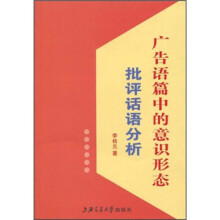广告语篇中的意识形态研究:批评话语分析

Acknowledgements
前言
List of Figures and Tables
Chapter One Introduction
1.1 Background of studies of advertising language
1.2 Research questions and significance of this study
1.3 Theoretical and methodological orientations of this study
1.4 Data collection
1.5 Organization of the dissertation
Chapter Two Theory Preliminaries
2.1 Introduction
2.2 Critical discourse analysis
2.2.1 From discourse analysis to critical discourse analysis
2.2.2 A survey of critical discourse analysis
2.3 The view of discourse in critical discourse analysis
2.3.1 Discourse vs. Text
2.3.2 Discourse as action
2.3.3 Discourse as ideologies
2.4 Ideology and power in language
2.4.1 Ideology
2.4.2 Power
2.4.3 The relationship among language, ideology and power
2.5 The text-oriented framework for analysing ideologies
2.5.1 Hallidayan paradigm : text functionality in context
2.5.2 Framework for analysing ideology in discourse: Fairclough s three-dimension model
2.6 Summary
Chapter Three Modality as Explicit Representation of Ideologies in Advertising Discourse
3.1 Introduction
3.2 The ideological nature of modality
3.3 Meaning dimensions and grammatical devices of modality
3.3.1 Meaning dimensions of modality
3.3.2 Grammatical devices of modality
3.4 Modality and its ideological meanings in advertising discourse
3.4.1 Ideological meanings of modality in advertising discourse: a case study
3.4.2 Modality distribution in advertising texts: empirical studies
3.5 Summary
Chapter Four Personal system as Representation of
Ideologies in Advertising Discourse
4.1 Introduction
4.2 The functions of personal pronouns:SFL perspective
4.3 The politics of some personal pronouns
4.3.1 "them and us" attitude
4.3.2 "me" and "you" :subjectivity or empathy
4.4 Ideological meanings of personal pronotms in ads
4.4.1 Characteristics of use of personal pronouns in ads
4.4.2 Personal pronouns work ideologically in building relations
4.5 Snmmary
Chapter Five Transitivity as Implicit Representation of Ideologies m Advertising Discourse
5.1 Introduction
5.2 Transitivity as the construal of experience
5.3 Transitivity as representation of ideologies
5.4 Transitivity system and the power relations in advertising discourse
5.5 Summary
Chapter Six Intertextnality as Representation of Ideologies in Advertising Discourse
6.1 Introduction
6.2 What is intertextuality
6.2.1 Bakhtin:dialogism and heteroglossia
6.2.2 Kristeva:intertextuality as dialogue between texts or text and social context
6.2.3 Other interpretations of the term "intertextuality"
6.2.4 Intertextuality and interdiscursivity
6.3 The ideological functions of intertextuality
6.4 Intertextuality as hegemonic struggle in advertising discourse
6.5 Summary
Chapter Seven Conclusion
7.1 Summary of this dissertation
7.2 Major findings
7.3 Limitations of this study
7.4 Suggestions for further research
Appendices
Bibliography
前言
List of Figures and Tables
Chapter One Introduction
1.1 Background of studies of advertising language
1.2 Research questions and significance of this study
1.3 Theoretical and methodological orientations of this study
1.4 Data collection
1.5 Organization of the dissertation
Chapter Two Theory Preliminaries
2.1 Introduction
2.2 Critical discourse analysis
2.2.1 From discourse analysis to critical discourse analysis
2.2.2 A survey of critical discourse analysis
2.3 The view of discourse in critical discourse analysis
2.3.1 Discourse vs. Text
2.3.2 Discourse as action
2.3.3 Discourse as ideologies
2.4 Ideology and power in language
2.4.1 Ideology
2.4.2 Power
2.4.3 The relationship among language, ideology and power
2.5 The text-oriented framework for analysing ideologies
2.5.1 Hallidayan paradigm : text functionality in context
2.5.2 Framework for analysing ideology in discourse: Fairclough s three-dimension model
2.6 Summary
Chapter Three Modality as Explicit Representation of Ideologies in Advertising Discourse
3.1 Introduction
3.2 The ideological nature of modality
3.3 Meaning dimensions and grammatical devices of modality
3.3.1 Meaning dimensions of modality
3.3.2 Grammatical devices of modality
3.4 Modality and its ideological meanings in advertising discourse
3.4.1 Ideological meanings of modality in advertising discourse: a case study
3.4.2 Modality distribution in advertising texts: empirical studies
3.5 Summary
Chapter Four Personal system as Representation of
Ideologies in Advertising Discourse
4.1 Introduction
4.2 The functions of personal pronouns:SFL perspective
4.3 The politics of some personal pronouns
4.3.1 "them and us" attitude
4.3.2 "me" and "you" :subjectivity or empathy
4.4 Ideological meanings of personal pronotms in ads
4.4.1 Characteristics of use of personal pronouns in ads
4.4.2 Personal pronouns work ideologically in building relations
4.5 Snmmary
Chapter Five Transitivity as Implicit Representation of Ideologies m Advertising Discourse
5.1 Introduction
5.2 Transitivity as the construal of experience
5.3 Transitivity as representation of ideologies
5.4 Transitivity system and the power relations in advertising discourse
5.5 Summary
Chapter Six Intertextnality as Representation of Ideologies in Advertising Discourse
6.1 Introduction
6.2 What is intertextuality
6.2.1 Bakhtin:dialogism and heteroglossia
6.2.2 Kristeva:intertextuality as dialogue between texts or text and social context
6.2.3 Other interpretations of the term "intertextuality"
6.2.4 Intertextuality and interdiscursivity
6.3 The ideological functions of intertextuality
6.4 Intertextuality as hegemonic struggle in advertising discourse
6.5 Summary
Chapter Seven Conclusion
7.1 Summary of this dissertation
7.2 Major findings
7.3 Limitations of this study
7.4 Suggestions for further research
Appendices
Bibliography
李桔元,湖南新化人,文学博士,杭州师范大学外国语学院副教授,硕士生导师,中国高校功能语言学研究会会员。主要研究兴趣为功能语言学、语篇分析以及英语教学等。在外语类核心期刊及其它重要期刊上发表学术论文20余篇,参编省级规划本科教材和词典各1部,主持并完成省教育厅课题1项、其他课题4项,主持校研究生优质课程建设1项,参与国家社科课题1项、省社科课题3项,曾作为第一主讲教师参与省级本科精品课程《综合英语》建设。
《广告语篇中的意识形态:批评话语分析》是语言学领域内有关批评话语分析的专著,也是第一本对广告语篇系统进行批评性研究的著作。批评话语分析是近年来国外发展迅速、国内正在兴起的一门关于语篇分析的理论与实践的学科。《广告语篇中的意识形态:批评话语分析》从理论上进一步厘清了批评话语分析的几个核心概念和结构体系,从实践上对作为公共语篇的广告语篇进行了较为系统的批评性分析,这在批评话语分析的具体应用上作出了有益的探索。
比价列表
公众号、微信群
 缺书网
缺书网微信公众号
 扫码进群
扫码进群实时获取购书优惠




